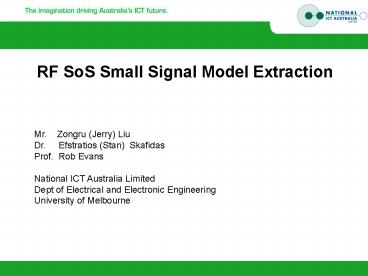60GHz - PowerPoint PPT Presentation
1 / 24
Title: 60GHz
1
RF SoS Small Signal Model Extraction
Mr. Zongru (Jerry) Liu Dr. Efstratios
(Stan) Skafidas Prof. Rob Evans National ICT
Australia Limited Dept of Electrical and
Electronic Engineering University of Melbourne
2
Talk Outline
- Why is Small Signal Model Important
- Overview of the Procedure
- Calibration Method
- 2-step De-embedding
- Extrinsic Parameter Extraction
- Intrinsic Model Extraction
- Results and Conclusion
3
Why is Small Signal Model Important
- 7GHz spectrum being made available worldwide
- Targeting low-cost, high-data-rate communication
applications using CMOS technology - Require accurate active and passive models at
these frequencies - Foundry supplied process development kit models
do not support these frequencies. - Usual technique is prone to failure especially at
these higher frequencies
4
Overview of the Procedure
Silicon on Saphire transistor
5
Overview of the Procedure
Transistor with parasitic components
illustrated
6
Overview of the Procedure
Transistor equivalent circuit
7
Overview of the Procedure
8
Calibration Method
- Lab setup
- using a calibration substrate and a self
consistent calibration model SUSS LRM
9
Overview of the Procedure
10
2-step De-embedding
Pads parasitic have to be removed
11
2-step De-embedding
Open and short structures build on chip to
extract PADs parasitic
12
2-step De-embedding
- The open standard can be used to determine the
parallel parasitics Yp1, Yp2, Yp3 - The short standard with the shunt parasitics Yp1,
Yp2, Yp3 and series parasitics Z1, Z2, and Z3
surrounding the transistor can be used to
determine and remove the pad parasitics
13
Overview of the Procedure
14
Extrinsic Parameter Extraction
The inclusion of the short-b permits an
accurate determination of the extrinsic elements
15
Extrinsic Parameter Extraction
- The lumped extrinsic elements are extracted by
performing a constrained least square fitting - The constraint is to ensure that the values of
inductance and resistance are positive
16
Overview of the Procedure
17
Intrinsic Parameter Extraction
- extrinsic elements must be subtracted to get the
intrinsic Y-matrix (Yin) - use right hand side formulas to get the initial
intrinsic elements - perform least square fittings to get the
intrinsic parameters
18
Intrinsic Parameter Extraction
- Equations are derived from the small signal
intrinsic model where is the estimates of
the intrinsic Y-matrix. - The cost function is minimized subject to the
constraint that all the extracted components are
positive
19
Talk Outline
- Why is Small Signal Model Important
- Overview of the Procedure
- Calibration Method
- 2-step De-embedding
- Extrinsic Parameter Extraction
- Intrinsic Model Extraction
- Results and Conclusion
20
Results
Extrinsic parameters
Intrinsic parameters
21
Results
- the measured and de-embedded S-parameters of one
of our transistors - The transistor is 3 fingers with finger width
8um, channel length 0.25 um. The bias condition
is Vds 1.5V, Vgs 0.8V.
22
Results
- the simulated S-parameter using Cadence Spectre
versus the measurements after de-embedding - Good agreement is obvious from the content
23
Conclusion
- A new extraction scheme has been demonstrated
which, after introduction of new structure
short-b, allows accurate and effective extraction
of all small-signal circuit elements values from
S-parameters measurements up to 65 GHz - The least square optimization technique is
applied to compensate for the noisiness of the
measurements - A two step de-embedding method has also been
demonstrated - The simulation results also show very well fit
with the measurements
24
References
- R. Broderson, Cmos for Ultra Wideband and 60 GHz
Communication, ISSCC Paper 24.4, pp. 440-441,
Feb 2004 - Berny, A.D., Niknejad, A.M., Meyer, R.G , A
1.8-GHz LC VCO with 1.3-GHz tuning range and
digital amplitude calibration IEEE J.
Solid-State Circuits, vol. 40, No 4, pp.909
917 April 2005 - R. Anholt and S.Swirhun, Equivalent-circuit
parameter extraction for cold GaAs MESFETs,
IEEE Tran. Microwave Theory Tech, vol. 39, pp.
1243-1247, 1991 - A. Bracale, V. Ferlet-Cavrois, N. Fel, D.
Pasquet, J.L. Gautier, J.L. Pelloie and J. Du
Port de Poncharra, A New Approach for SOI
Devices Small-Signal Parameters Extraction,
Analog Integrated Circuits and Signal Processing,
25, 157-169, 2000 - J.P. Raskin, R. Gillon, J. chen, D.V. Janvier and
J.P. Colinge, Accurate SOI MOSFET
Characterization at Microwave Frequencies for
Device Performance Optimization and Analog
Modeling, IEEE Trans. on Electron Devices, vol.
45, No. 5, May 1988 - M.C.A.M. Koolen, J.A.M. Geelen and M.P.J.G.
Versleijen, An Improved De-embedding Technique
for On-wafer High-Frequency Characterization,
IEEE 1991 Bipolar Circuit and Technology Meeting
8.1. - G. Dambrine, A. Cappy, F. Heliodore, and E.
Playez, A new method for determining the FET
small-signal equivalent circuit, IEEE Trans.
Microwave Theory Tech, vol. 36 , No. 7,
pp.1151-1159, July 1988.































